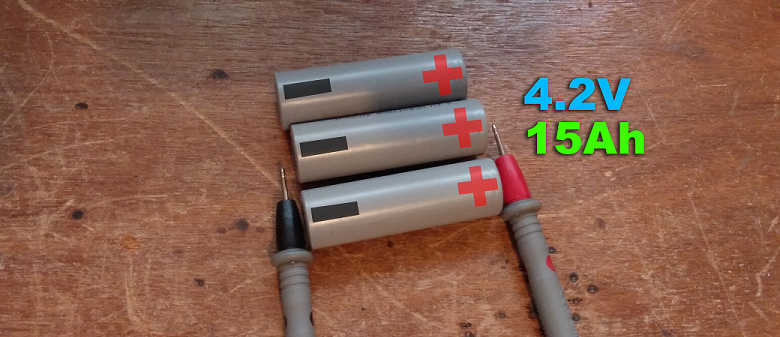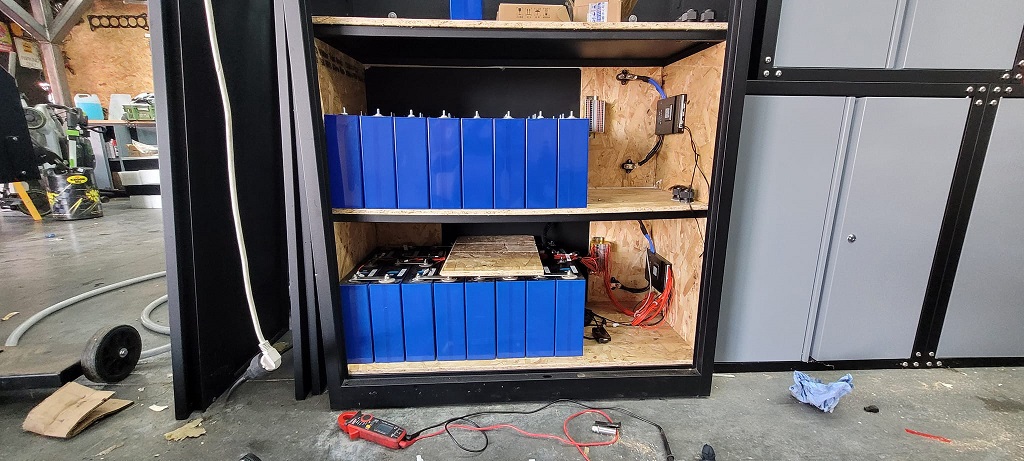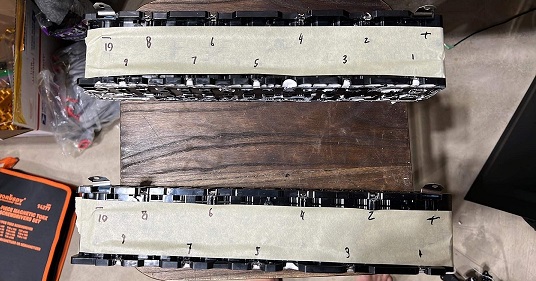
How To Wire Lithium Batteries In Parallel Increase Amperage
Table of Contents
If your load requires more current than a single battery can provide, but the voltage of the battery is what the load needs, then you need to add batteries in parallel to increase amperage. Wiring batteries in parallel is an extremely easy way to double, triple, or otherwise increase the capacity of a lithium battery.
When wiring lithium batteries in parallel, the capacity (amp hours) and the current carrying capability (amps) are added, while the voltage remains the same. Because the voltage stays the same no matter how many batteries are added in parallel, little to no other precautions need to be considered. When wiring lithium-ion batteries in series, the voltage is changed which can damage equipment if not performed with caution and great understanding. In contrast, wiring lithium batteries in parallel keeps the voltage the same while simply giving the batteries the ability to supply that same voltage level for longer. The batteries are wired in parallel, the load current is split among the batteries in the group. If you have 2 batteries wired in parallel, they will each experience 50% of the total load current. In the same respect, if 5 batteries are wired in parallel, each battery will only experience 20% of the total load current.
In this article, we will explain how to wire lithium batteries in parallel to increase amperage and capacity. We will also explain a few use cases where wiring lithium batteries in parallel is ideal, and we will discuss some fundamental differences between series and parallel battery configurations.
Why Wire Lithium Batteries In Parallel?
Battery cells are wired in parallel to increase their capacity and increase the amount of current that they can handle. This is useful when building a battery pack out of 18650 cells that has large capacity requirements like building a DIY powerwall or high amperage requirements like when building ebike battery. For example, if you have a 24-volt battery that is capable of providing 20 amps of current, that means that the maximum wattage of a device that you can run with that battery would be 480 watts.
If you need to run a 700-watt device, which at 24 volts would be a device that requires 29.2 amps, you will have to add batteries in parallel to increase amperage.
When batteries are wired in parallel, the load current is split between the two. So if a single 24-volt battery is capable of producing 20 amps of current, putting them in parallel will raise the load current limit to 40 amps, which is 960 watts.
As long as the two batteries have the same resistance or their resistances are close enough considering the amount of current your load requires, then they will each experience 50 percent of the load current.
In this configuration and when running a 700-watt load, each battery only experiences about 15 amps of load current.
In this configuration, each battery would be running at about 75% of its maximum rated capacity, while powering a device that requires about 150% of a single battery's rated capacity.
Single-Cell Lithium Ion Capacity Limits
While it is true that you can technically run a 12V inverter on just 3 lithium-ion cells in series, it wouldn’t run that long. For example, putting three 5000mah cells in series would create a battery with a nominal voltage of 11.1 volts and a capacity of 5ah. A 12V inverter will run at that voltage more or less just as well as it would at 12 volts.
This is especially true considering the full charged voltage of a 3S lithium-ion battery pack is 12.6 volts. But the question still remains: How long could such a small battery run an inverter?
Let’s say we are running a TV that consumes 120W watts of energy per hour. A nominal voltage of 11.1 multiplied by a cell capacity of 5 amp hours equals 55.5 watt-hours of energy.
To estimate how long something will run on a given battery, all you have to do is divide the number of watt-hours available in the battery pack by the number of watts per hour your load uses.
It is important to consider, however, that no system is 100 percent efficient. Most inverters are about 90% efficient. So, if your TV requires 120 watts to run, the inverter will have to draw about 132 watts from the battery.
NOTE: 3 lithium-ion cells in series produce a battery that has a fully charged voltage of 12.6 volts and a dead voltage of around 8.9 volts. Most inverters will stop working at around the 10.5-volt mark, so you will only get about 30Wh of usable energy out of 3 lithium-ion cells when they are being used to power an inverter.
It’s clear to see that single lithium-ion cells, while very impressive, don’t have enough capacity to run most consumer electronics for any reasonable amount of time. This is one of the many reasons why it’s important to know how to wire lithium batteries in parallel.
How To Wire Lithium Cells In Parallel
Wiring cells in parallel is an extremely simple and straightforward procedure. Simply connect all the positive connections for each cell together and all the negative connections for each cell together. Cells that are wired in parallel are self-balancing.
This means that if there is any voltage difference between the two or more cells that are being wired in parallel, those differences will naturally balance out as energy from the higher cell or cells moves to the cell or cells with lower energy.
It’s important to consider that this transfer of energy is completely uncontrolled. If the voltage difference between two or more cells that are being connected in parallel is too high, the cells will get hot and can become damaged. In a worst-case scenario, it could cause a fire.
This is why it is absolutely critical to make sure that the cells you are connecting in parallel have voltages that are no more than 0.1 volts apart.
How To Wire Lithium Batteries In Parallel To Increase Amperage
Wiring batteries in parallel is the same process as wiring cells in parallel. All you need to do is connect positive to positive and negative to negative. When connecting batteries in parallel, energy will move from the higher-voltage battery to the lower-voltage battery and they will naturally balance.
The problem with this is that it's an unregulated amount of energy that is transferred. For this reason, it's important to make sure that the voltages of the batteries you are connecting in parallel are not different from .1 volts.
If you are wiring 4 equal batteries together and they each have a BMS that is rated for 50A of load current, the resulting battery will be able to support 200 amps of load current, and if the load current was 50 amps, each battery would only experience 12.5 amps.
How Parallel Connections Work
In a parallel connection, two or more power sources are connected to the same load. The power sources are connected in such a way that they support each other electrically. This is why it's called a parallel connection, as all power sources are connected to the same load using the same 2 points for positive and negative.
How To Charge In Parallel
Charging cells in parallel is not much different than charging them on their own. For example, if you have a single lithium-ion cell that has a max charge voltage of 4.2 volts and a max charge current of 2 amps, you can use those same settings to charge a battery that has 3, 20, or even 100 of those battery cells in parallel.
The problem is that it will take a whole lot longer to charge if the current is not increased. If it took 3 hours to fully charge one cell, then it would take 15 hours to fully charge 5 of those same cells connected in parallel. The good news is that when charging cells in parallel, the charging current is equally split between each cell. So, if you have 3 cells in parallel and each one of them can take a 2 amp charge current, you will be able to the 3-cell parallel group at 6 amps.
The process is no different to charge complete batteries in parallel, and unlike putting batteries in series, there is no need to worry about the MOSFETs getting damaged, as putting batteries in parallel does not change the voltage. It is, however, still very important to make sure that the batteries are at the same voltage level before connecting them.
How Do You Balance Lithium Batteries In Parallel?
Once lithium-ion batteries are connected in parallel, they will balance themselves. This process, however, can be both dangerous and slow. If the cells are not balanced before connecting them, then there will be a substantial voltage difference between cells which will cause an unknown (and possibly massive) amount of current to flow between the higher and lower-voltage cells. To learn how to balance a lithium battery pack we did a write-up on it which we suggest reading to avoid any possible damage.
In contrast, if you get the cells very close in voltage and then rely on the internal self-balancing to do the rest, it will take a very long time before they all completely equalize. The good news is that once they are connected in parallel, this process happens continuously and on its own.
Conclusion
Lithium-ion batteries are extremely power dense and over the last 10 years, the cost of a given amount of lithium-ion energy has come down 10-fold. There are, however, two major shortcomings when it comes to lithium-ion battery cells. First, the capacity of a single cell is quite low. At the time of this writing, a single cell or series chain of 18650 cells will have a maximum capacity of about 3600ma. When it comes to 21700 cells, this figure is about 5000ma.
Secondly, while there are some very high current capacity cells out there, most lithium-ion battery cells can only handle 5 to 15 amps of current. For these two reasons, it's important to know how to wire lithium batteries in parallel, as it increases both capacity and current carrying capability.
When lithium batteries are wired in parallel, their capacities (amp hours) and ability to carry current are added, but the voltage is left unchanged. Because the voltage doesn’t change, there is not much to worry about in terms of safety or compatibility. It is, however, important that any two power sources that are being connected in parallel have the same voltage before they are connected. Other than that, there is not much to worry about. One thing to consider is that with more cells or batteries connected in parallel, the same charger used to charge one battery will take longer to fully charge the new parallel configuration. When lithium cells or batteries are wired in parallel, the current is split between all power sources in the group. To connect any two power sources in parallel, simply connect all positive connections together and all negative connections together.
We hope this article helped you learn more about how to wire lithium-ion batteries in parallel. Thanks for reading!



